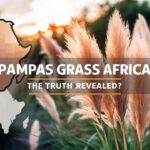Introduction: Is Pampas Grass Natural?
Is pampas grass natural? This question often arises for gardening enthusiasts and environmentalists alike. The tall, feathery plumes of pampas grass (Cortaderia selloana) can be seen waving in the wind, adding an elegant touch to landscapes. But is this beautiful plant a natural part of the ecosystems it inhabits, or is it an introduced species with potential ecological consequences?
What is Pampas Grass?
Pampas grass is a perennial grass native to South America, particularly the Pampas region of Argentina, Uruguay, and Brazil. Known for its striking, fluffy plumes, it can grow up to 10 feet tall, making it a popular choice for ornamental gardening. But beyond its aesthetic appeal, many people wonder, “Is pampas grass natural in all regions where it grows?”
The Origins of Pampas Grass
Native Habitat
The natural habitat of pampas grass is the vast, fertile lowlands of the Pampas in South America. In these regions, the plant thrives in temperate climates with moderate rainfall. Its deep root system allows it to survive in various soil types, from sandy to clay-rich soils.
Adaptation and Spread
Pampas grass has adapted well to its native environment, flourishing in open spaces where it can receive plenty of sunlight. Its ability to spread rapidly through both seeds and vegetative growth has contributed to its success in the wild.
Pampas Grass in Its Natural Habitat
In its natural habitat, pampas grass plays a significant role in the ecosystem. It provides shelter for various wildlife species and helps prevent soil erosion. The plant’s dense root system stabilizes the soil, making it an important component of the natural landscape in the Pampas region.
The Spread of Pampas Grass Worldwide
Introduction to Other Regions
Is pampas grass natural to regions outside South America? The answer is no. However, its striking appearance and hardiness have led to its introduction in many parts of the world, including North America, Europe, Australia, and New Zealand. Gardeners and landscapers appreciate its decorative qualities, but this introduction has not been without consequences.
Invasive Species Concerns
In many of these regions, pampas grass is considered an invasive species. Its aggressive growth can outcompete native plants, disrupt local ecosystems, and create fire hazards due to the accumulation of dry, dead foliage. As a result, managing its spread has become a priority in many areas.
Environmental Impact of Pampas Grass
Ecosystem Disruption
The introduction of pampas grass to non-native regions can significantly disrupt local ecosystems. It often forms dense stands that crowd out native vegetation, reducing biodiversity. This displacement of native plants can have a cascading effect on the local wildlife that depends on them for food and shelter.
Fire Hazards
Another major concern with pampas grass is its potential to create fire hazards. The plant’s dry leaves and plumes are highly flammable, increasing the risk of wildfires, especially in dry, hot climates. This poses a significant threat to both natural habitats and human settlements.
Managing Pampas Grass in Your Garden
Cultivation Tips
For those who wish to cultivate pampas grass in their gardens, it’s important to do so responsibly. Choose sterile varieties that do not produce viable seeds to prevent unwanted spread. Regularly remove dead foliage to minimize fire risks and prevent the plant from becoming too invasive.
Alternative Options
Consider native grasses and plants as alternatives to pampas grass. They can offer similar aesthetic appeal while supporting local biodiversity and reducing the risk of invasive species problems.
Conclusion
So, is pampas grass natural? While it is native to the Pampas region of South America, its introduction to other parts of the world has led to various ecological challenges. Understanding its origins and potential impact is crucial for gardeners and environmentalists. By managing its growth responsibly and considering native alternatives, we can enjoy its beauty without compromising our local ecosystems.
FAQs
1. Is pampas grass harmful to the environment?
Yes, in many non-native regions, pampas grass is considered an invasive species that can outcompete native plants and create fire hazards.
2. Can I plant pampas grass in my garden?
Yes, but it’s important to choose sterile varieties and manage the plant responsibly to prevent it from becoming invasive.
3. Where is pampas grass originally from?
Pampas grass is originally from the Pampas region of South America, including parts of Argentina, Uruguay, and Brazil.
4. What are some alternatives to pampas grass?
Consider planting native grasses and plants that offer similar visual appeal while supporting local ecosystems.


